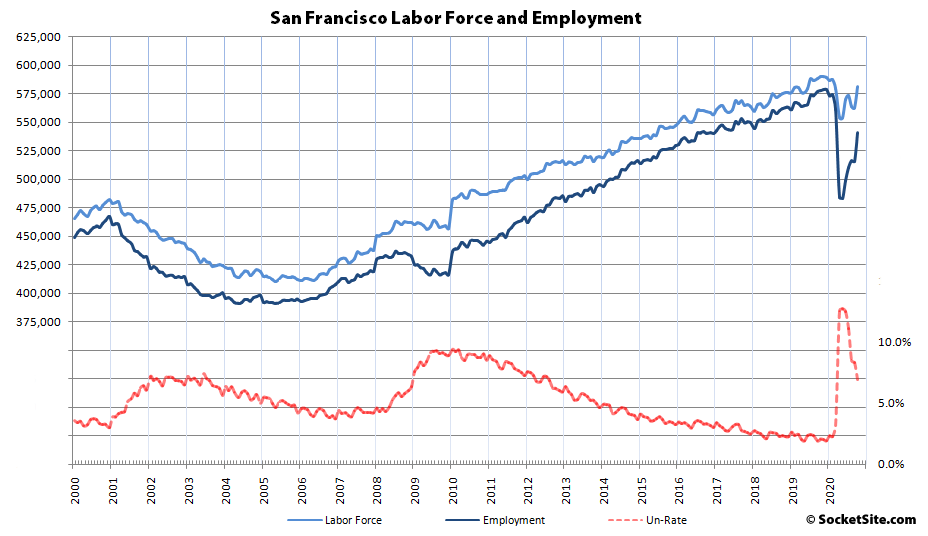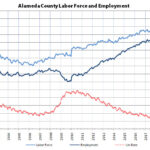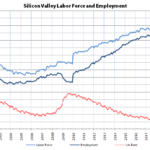Having sputtered in September, the number of people living in San Francisco with a paycheck jumped by 25,400 last month, driving the unemployment rate, which had been averaging around 2 percent prior to the pandemic but jumped to 12.6 percent in April, back down to 6.9 percent.
That being said, there are still 32,800 fewer employed people in the city than there were prior to the pandemic and 36,600 fewer than at the same time last year. And while the Labor Force count in the city jumped by 18,800 in October to 581,100, that still represents 6,100 fewer people than prior to the pandemic and 8,700 fewer than at the same time last year.
The trend was roughly the same across the other eight Bay Area counties, with the unemployment rate across the East Bay dropping from 9.2 in September to 8.0 percent in October and the blended unemployment rate in San Mateo and Santa Clara counties dropping from 7.0 to 5.9 percent with Santa Clara recording the largest jump in re-employment last month, up 49,000 in October to just over a million employed, an increase of 5.2 percent.
And as such, the blended Bay Area unemployment rate, which was down to 2.3 percent prior to the pandemic, has dropped back down to 6.9 percent with 3,876,200 employed, which is up by 179,600 from September but still 195,200 fewer than prior to the pandemic (and 237,500 fewer employed residents than at the same time last year), with a Labor Force count that rebounded by 142,500 last month to 4,161,600 (which is still down by 56,100, year-over-year).




Some of this is through the re-opening of things like restaurants. However, those are closed again, so I would not be surprised to see the numbers fall again.
Indeed, and w/ no ‘stimulus’ ready at hand, and the cumulative effect(s) of – now – fast approaching a year of having been shutdown, we may begin to see an exponential spread of business failures. This site is fond of the phrase “tipping point’…that would be what you’d call it.
If there isn’t a stimulus, things will probably get much worse in the very short term. It’s hard to say whether that will affect San Francisco more or less than the country at large. Although the medium term is looking better with the recent vaccine news.
I think there has to be a stimulus. McConnell runs too much risk in GA without setting one in motion.
That would be rational but at this point I have no idea what happens next in DC.
Regarding the vaccine, no claim has been made past 95% efficacy. This leaves 5% where it may not work. Further, vaccine (correct me if I am wrong here) only assists in fighting off the infection. But doesn’t stop contraction and re-transmission.Seems to me this thing can bounce around for quite a while before immunity is attained to and re-transmissions are stopped. It could be that we may witness more lockdowns before the situation returns to normal.
herd immunity is reach at 70%, so the 5% not that important as will be mostly protected, as long as 75% of others get the vaccine.
dont know yet if vaccines stop contraction, but should find out soon. the answer imho is probably does.
after this mornings news of a 3rd positive vaccine, its clear that spike protein target was the right one, so JnJ and Novavax vaccines will also likely be effective. this means will have 1 by Dec, 3 by Jan and likely 5 by Feb. We will be back to nearly normal by summer.
There seems to be contractions regarding infection and re-infection/re-transmission. Or at least it doesn’t seem to be conclusive at the moment.
This article Understanding COVID-19 vaccine efficacy article suggests that vaccine might actually prevent susceptibility to infection — that would be great news. However this article “notes that neither Moderna nor the Pfizer/BioNTech study evaluated whether the vaccine prevented infections as well as symptomatic disease, which is key to controlling the spread of the virus. “The data we have are that these vaccines protect you against severe illness, but it doesn’t mean that you can’t get infected and give it to your patient, your neighbor, your customer, or whomever.”
I am no epidemiologist nor an immunologist nor in any way medically qualified. I do hope things will change for the better and we can go back to normal at the earliest.
Most small business leases are signed by the business owner personally. That means you have to stick it out till the lease ends, squeezing what you can out of the space until your lease is up. If you walk away, you still owe all the rent, but lose the opportunity to recoup 10-30% of what you were getting before.
So I doubt you’ll see any exponential spread.
Once the small business proprietor is over a certain amount in arrears, it makes economic sense to just list the lessor as a creditor on the Chapter 13 bankruptcy paperwork and move on. Sure you won’t get away scot free, but you’ll probably be able to force the landlord to accept a haircut on “all the rent”.
I sure hope most small business owners avail themselves of this.
What does having a bankruptcy in your record do to your chances of opening another restaurant in the future? Maybe landlords and lenders will be more understanding about Covid-era bankruptcies, but it’s a hard enough business as it is.